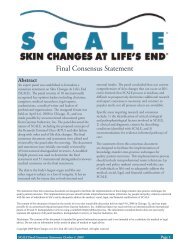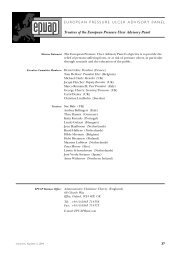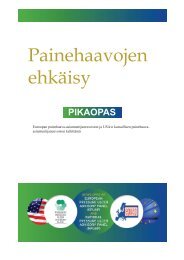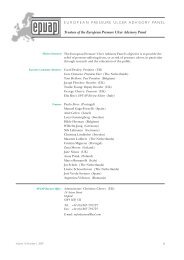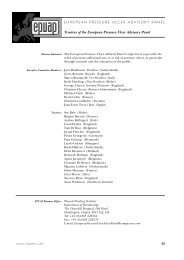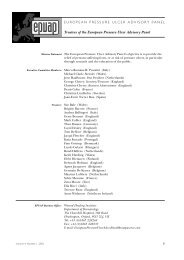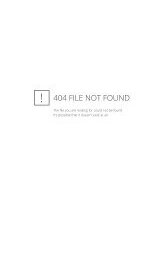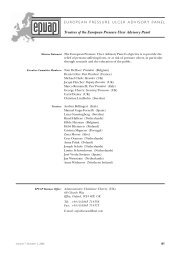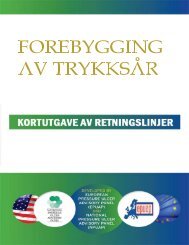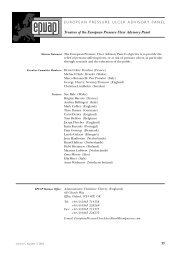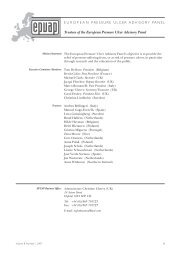EPUAP Review 5/2 RIP - European Pressure Ulcer Advisory Panel
EPUAP Review 5/2 RIP - European Pressure Ulcer Advisory Panel
EPUAP Review 5/2 RIP - European Pressure Ulcer Advisory Panel
You also want an ePaper? Increase the reach of your titles
YUMPU automatically turns print PDFs into web optimized ePapers that Google loves.
64<br />
epuap News<br />
EUROPEAN PRESSURE ULCER ADVISORY PANEL<br />
from the Netherlands<br />
A NEW EVIDENCE-BASED PRACTICE GUIDELINE<br />
ON PRESSURE ULCER PREVENTION AND MANAGEMENT<br />
IN 2002 new guidelines on pressure ulcer prevention<br />
and management were released in the Netherlands.<br />
These evidence-based guidelines built upon the literature<br />
review conducted during the development of the<br />
United States Agency for Health Care Policy and Research<br />
(AHCPR) pressure ulcer guidelines issued in the early 1990s.<br />
As such the new Dutch guidelines offer new insights into<br />
the management of pressure ulcer prevention and management<br />
given their foundation upon new research studies<br />
and an awareness of literature published in languages other<br />
than English. The <strong>European</strong> <strong>Pressure</strong> <strong>Ulcer</strong> <strong>Advisory</strong> <strong>Panel</strong><br />
would like to acknowledge CBO, Dutch Institute for Quality<br />
in Health Care (Kwaliteitsinstituut voor de Gezondheidszorg)<br />
CBO, PO Box 20064, 3502 LB Utrecht, the Netherlands<br />
for their kind permission to present an edited version<br />
of these new guidelines within the <strong>EPUAP</strong> <strong>Review</strong>. In<br />
this issue we cover the methodological issues related to the<br />
development of the new guidelines.<br />
Why was the new guideline developed?<br />
Recent years have seen greater focus upon the problem of<br />
pressure ulcers in the Netherlands at a political and economic<br />
level. For example political initiatives have included<br />
a report on pressure ulceration to the Secretary of Health<br />
and the Health Council. 1 This report was followed by a written<br />
reply to the report’s conclusions submitted by the Health<br />
Minister to the Dutch House of Commons. In parallel with<br />
these political issues there has been a growth in the availability<br />
of national epidemiological data 2 along with a<br />
stronger awareness of the economic impact of pressure ulcers.<br />
3–18 In the Netherlands approximately 13% of all patients<br />
in teaching hospitals have pressure ulcers, the prevalence<br />
then rises in home care (17%), general hospitals<br />
(23%) and to about 30% in nursing homes 2 while the annual<br />
spend on pressure ulcer care is about 600 million Euros<br />
with a total population of 16 million. 16–17 These developments<br />
have not occurred in a vacuum; Dutch demography<br />
has changed over the past ten years with greater numbers<br />
of elderly people, while the scientific basis for pressure ulcer<br />
prevention and management has also advanced. Taken<br />
together there was perceived to be a need to revise earlier<br />
consensus texts developed in the Netherlands during the<br />
mid 1980s, and to update the US AHCPR guidelines that<br />
date from 1992. This update of the guideline was commissioned<br />
by the CBO (Dutch quality organization for health<br />
care) with all relevant interest groups represented in the<br />
working group established to direct the guideline update.<br />
What is the purpose of the new guideline?<br />
Essentially the guideline must be appropriate for use in daily<br />
medical, nursing and paramedical practice giving sound recommendations<br />
and practical advice. All patient groups and<br />
care settings are to be covered by the guideline’s recommendations<br />
– both those with an elevated risk of developing<br />
pressure ulcers and those with established pressure ulcers.<br />
One important consideration was that the guideline<br />
should seek to facilitate the co-ordination of care both within<br />
and between institutions.<br />
Definition of pressure ulceration used<br />
throughout the guideline<br />
In this guideline, ‘pressure ulcer’ should be considered to<br />
refer to any tissue damage caused by mechanical loading<br />
(pressure, shear and friction alone or in combination).<br />
Developing the guideline<br />
In 2000 a Working Group was formed to lead the development<br />
of the new guideline (See Appendix 1 for composition<br />
of the group) formed of society representatives and<br />
active researchers. In particular this latter group comprised<br />
of post-doctoral fellows drawn from the Netherlands and<br />
Belgium and collectively known as the <strong>European</strong> <strong>Pressure</strong><br />
<strong>Ulcer</strong> Research Interest Group (EPURIG).<br />
The working group first met on 11 May 2000 and separated<br />
the guideline development into two phases – development<br />
of the recommendations, and commentary from<br />
appropriate stake-holders. The EPURIG members were<br />
tasked to identify the relevant literature, review it and form<br />
draft recommendations. The primary role of the scientific<br />
society representatives was to provide comment upon these<br />
draft recommendations. Studies to be included in the review<br />
were to have been published since the AHCPR pressure<br />
ulcer prevention guideline issued in 1992. Initially it<br />
was anticipated that the latest date of publication to be covered<br />
by the review was Summer 2000 but this process extended<br />
to include new publications for a further twelve<br />
months (Summer 2001). Throughout the review process<br />
close co-operation was sought with relevant Dutch steering<br />
committees and <strong>European</strong> and North American pressure<br />
ulcer organizations (<strong>EPUAP</strong> and NPUAP).<br />
During the initial meeting, the chair of the working<br />
group proposed the guideline be divided into five sections<br />
covering:<br />
Volume 5, Number 2, 2003



